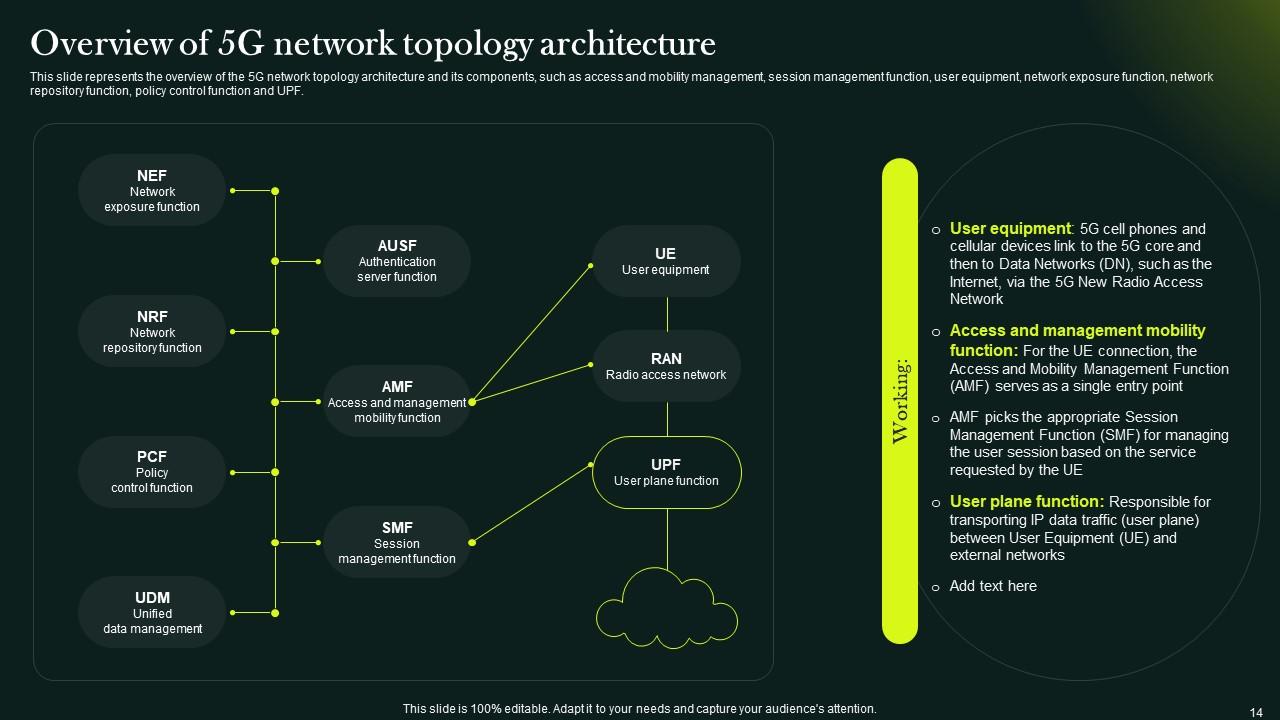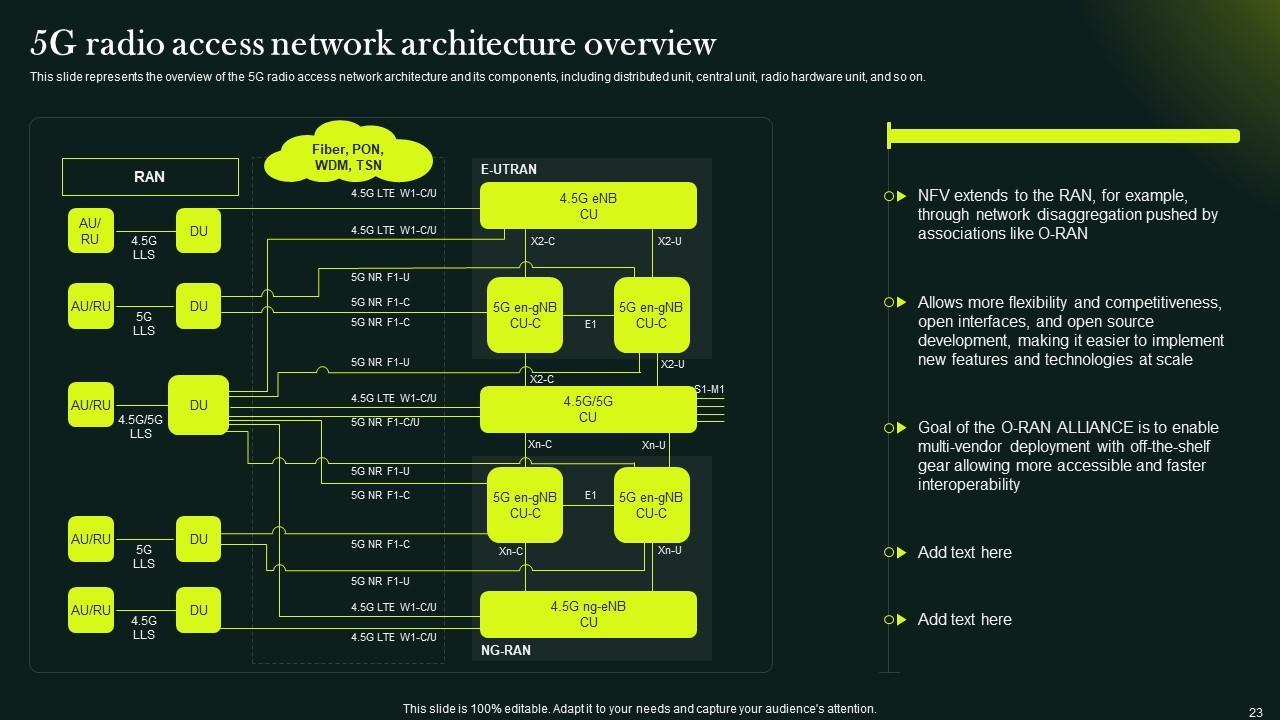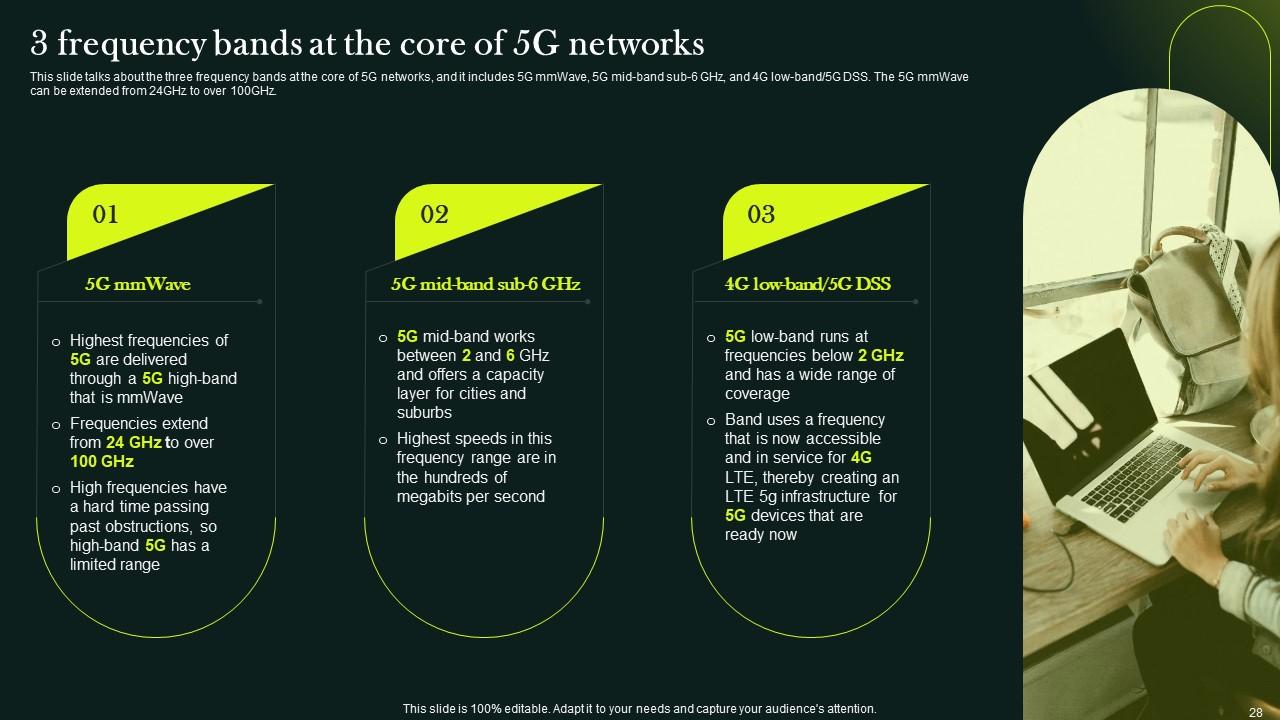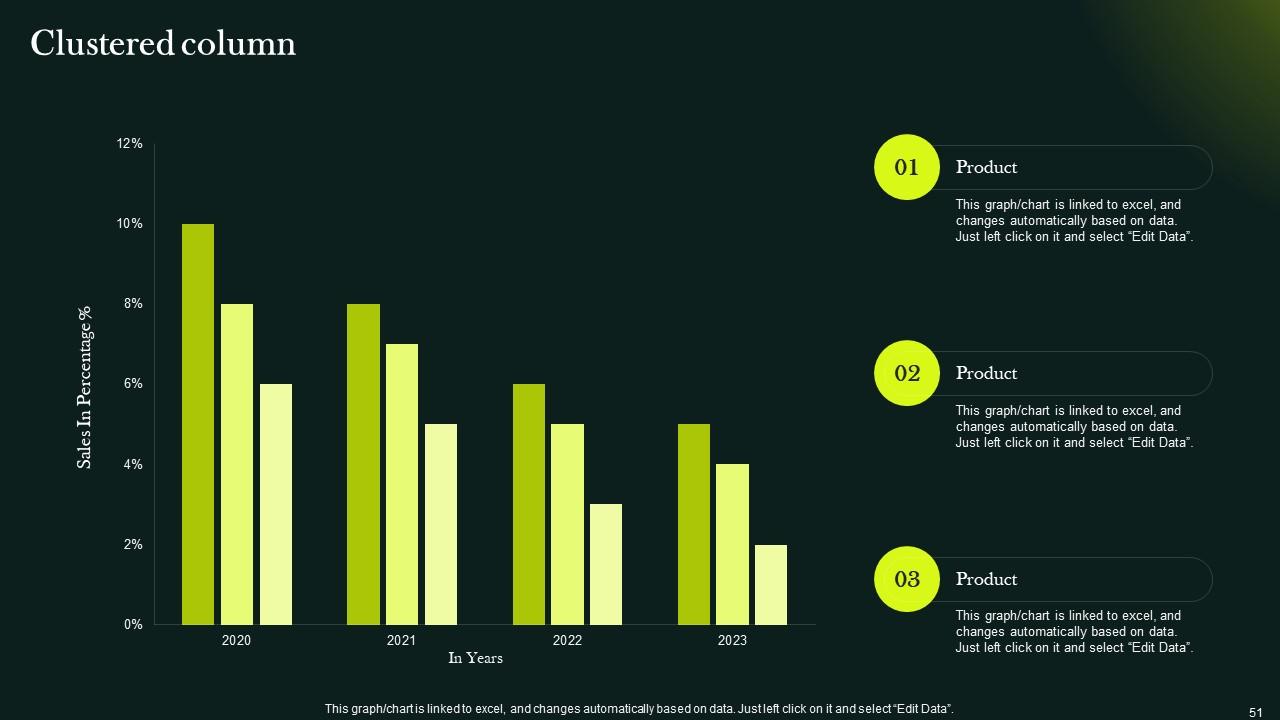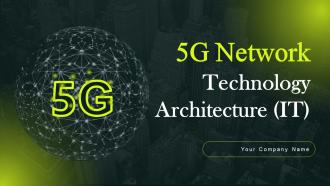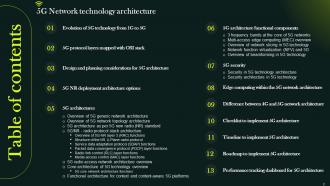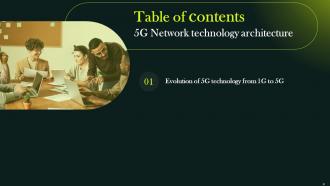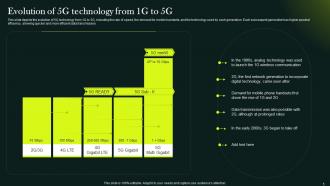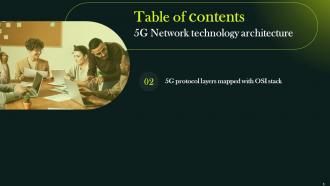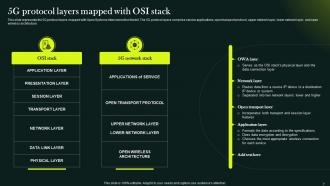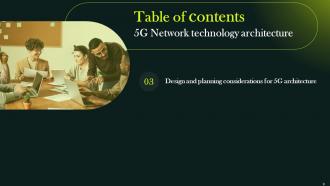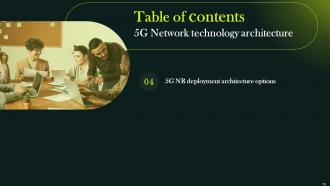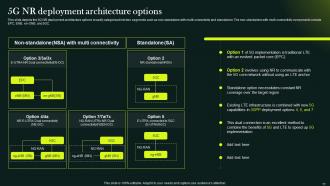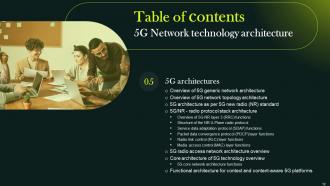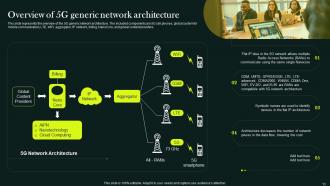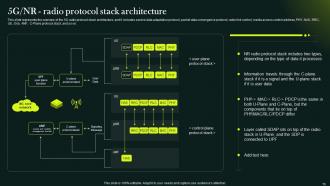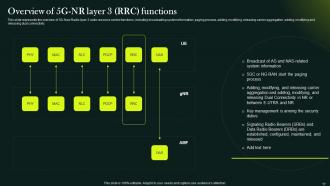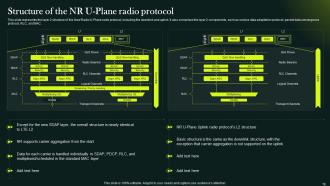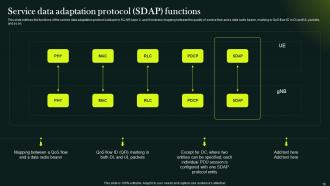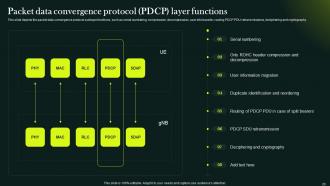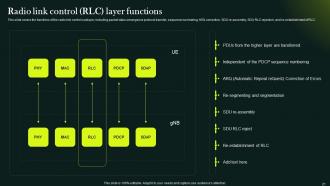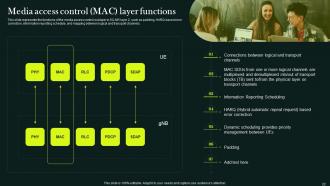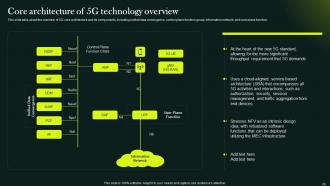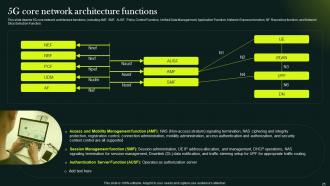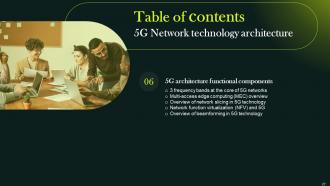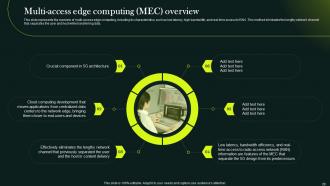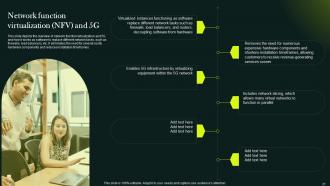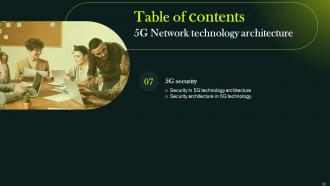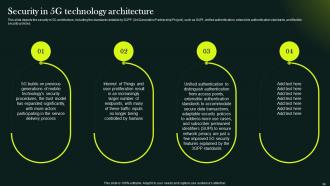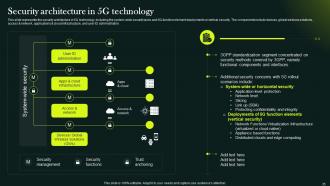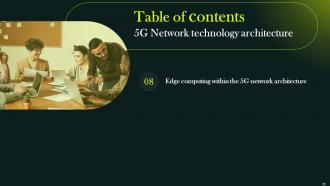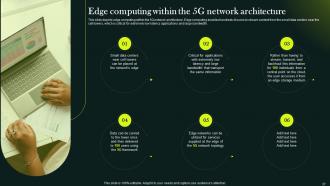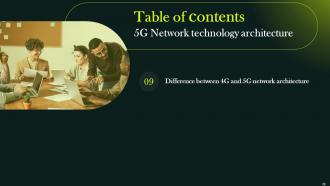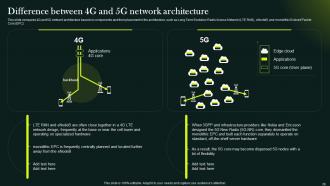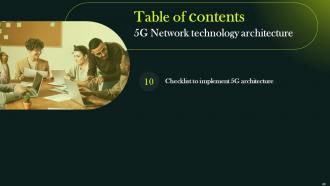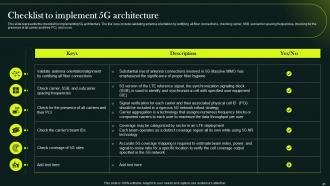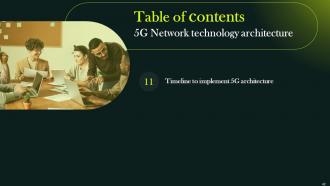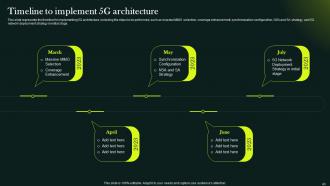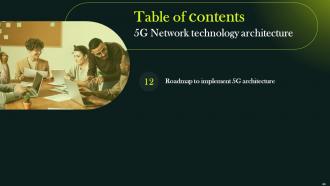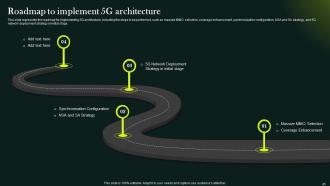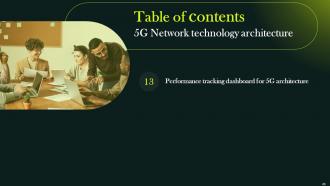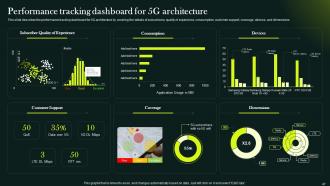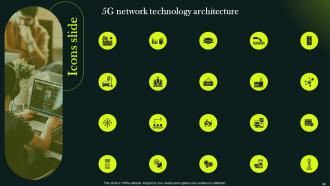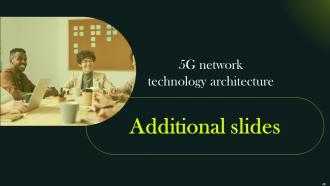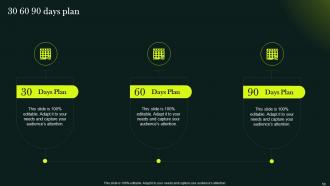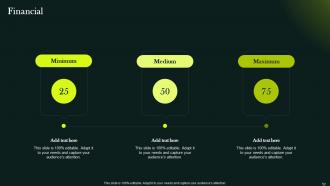5G Network Technology Architecture Powerpoint Presentation Slides
By providing more excellent peak data rates of several Gbps, 5G wireless technology increases efficiency and efficacy. Grab our smartly designed 5G Technology Architecture template. It gives a brief overview of how 5G technology works and how the shift from 1G to 5G happened. The OSI stack mapping for the 5G protocol levels, design and planning considerations, and implementation options are all included in our 5G Generic Architecture deck. It covers the various 5G designs, like the 5G generic network, and demonstrates the operation of the NR RRC, NR U-plane, SDAP, PDCP, RLC, and MAC Layers. Our 5G NR Standard Architecture PPT also covers the 5G radio access network, its fundamental design, and the functional architecture for context- and content-aware 5G platforms. Additionally, it shows the practical elements of the architecture, such as the frequency bands at the center of 5G networks, MEC, network slicing, a checklist for implementing the architecture, and many more. Lastly, our 5G Core Architecture module includes a dashboard for recording the success of the 5G architecture, a timeline, and a roadmap for its implementation. Get access right away.
- Google Slides is a new FREE Presentation software from Google.
- All our content is 100% compatible with Google Slides.
- Just download our designs, and upload them to Google Slides and they will work automatically.
- Amaze your audience with SlideTeam and Google Slides.
-
Want Changes to This PPT Slide? Check out our Presentation Design Services
- WideScreen Aspect ratio is becoming a very popular format. When you download this product, the downloaded ZIP will contain this product in both standard and widescreen format.
-

- Some older products that we have may only be in standard format, but they can easily be converted to widescreen.
- To do this, please open the SlideTeam product in Powerpoint, and go to
- Design ( On the top bar) -> Page Setup -> and select "On-screen Show (16:9)” in the drop down for "Slides Sized for".
- The slide or theme will change to widescreen, and all graphics will adjust automatically. You can similarly convert our content to any other desired screen aspect ratio.
Compatible With Google Slides

Get This In WideScreen
You must be logged in to download this presentation.
PowerPoint presentation slides
Deliver this complete deck to your team members and other collaborators. Encompassed with stylized slides presenting various concepts, this 5G Network Technology Architecture Powerpoint Presentation Slides is the best tool you can utilize. Personalize its content and graphics to make it unique and thought-provoking. All the fifty five slides are editable and modifiable, so feel free to adjust them to your business setting. The font, color, and other components also come in an editable format making this PPT design the best choice for your next presentation. So, download now.
People who downloaded this PowerPoint presentation also viewed the following :
Content of this Powerpoint Presentation
Slide 1: This slide introduces 5G Network Technology Architecture (IT). Commence by stating Your Company Name.
Slide 2: This slide depicts the Agenda of the presentation.
Slide 3: This slide incorporates the Table of contents.
Slide 4: This slide highlights the Title for the Topics to be discussed further.
Slide 5: This slide depicts the evolution of 5G technology from 1G to 5G.
Slide 6: This slide mentions the Heading for the Contents to be covered next.
Slide 7: This slide represents the 5G protocol layers mapped with Open Systems Interconnection Model.
Slide 8: This slide reveals the Title for the Ideas to be discussed in the following template.
Slide 9: This slide describes the design and planning considerations for 5G architecture.
Slide 10: This slide indicates the Heading for the Ideas to be covered in the forth-coming template.
Slide 11: This slide depicts the 5G NR deployment architecture options broadly categorized into two segments.
Slide 12: This slide elucidates the Title for the Components to be discussed next.
Slide 13: This slide represents the overview of the 5G generic network architecture.
Slide 14: This slide portrays the Overview of 5G network topology architecture.
Slide 15: This slide depicts the 5G architecture as per the 5G NR standard.
Slide 16: This slide showcases the overview of the 5G radio protocol stack architecture.
Slide 17: This slide presents the Overview of 5G-NR layer 3 (RRC) functions.
Slide 18: This slide reveals the layer 2 structure of the New Radio U-Plane radio protocol.
Slide 19: This slide outlines the functions of the service data adaptation protocol sublayer in 5G-NR layer 2.
Slide 20: This slide talks about Packet data convergence protocol (PDCP) layer functions.
Slide 21: This slide mentions the Radio link control (RLC) layer functions.
Slide 22: This slide shows the functions of the media access control sublayer in 5G-NR layer 2.
Slide 23: This slide represents the overview of the 5G radio access network architecture and its components.
Slide 24: This slide talks about the Core architecture of 5G technology overview.
Slide 25: This slide exhibits the 5G core network architecture functions.
Slide 26: This slide depicts the Functional architecture for context and content-aware 5G platforms.
Slide 27: This slide portrays the Heading for the Topics to be discussed next.
Slide 28: This slide talks about the three frequency bands at the core of 5G networks.
Slide 29: This slide showcases the Multi-access edge computing (MEC) overview.
Slide 30: This slide indicates the Overview of network slicing in 5G technology.
Slide 31: This slide deals with Network function virtualization (NFV) and 5G.
Slide 32: This slide portrays the Overview of beamforming in 5G technology.
Slide 33: This slide includes the Title for the Topics to be discussed in the following template.
Slide 34: This slide depicts the security in 5G architecture, including the standards detailed by 3GPP (3rd Generation Partnership Project).
Slide 35: This slide represents the security architecture in 5G technology.
Slide 36: This slide displays the Heading for the Contents to be covered next.
Slide 37: This slide reveals edge computing within the 5G network architecture.
Slide 38: This slide mentions the Title for the Ideas to be discussed further.
Slide 39: This slide compares 4G and 5G network architecture based on components and their placement in the architecture.
Slide 40: This slide indicates the Heading for the Ideas to be covered in the following template.
Slide 41: This slide represents the checklist for implementing 5G architecture.
Slide 42: This slide includes the Title for the Contents to be discussed next.
Slide 43: This slide presents the timeline for implementing 5G architecture.
Slide 44: This slide displays the Heading for the Topics to be covered further.
Slide 45: This slide reveals the roadmap for implementing 5G architecture.
Slide 46: This slide indicates the Title for the Ideas to be further discussed.
Slide 47: This slide describes the performance tracking dashboard for 5G architecture.
Slide 48: This is the Icons slide containing all the Icons used in the plan.
Slide 49: This slide is used for depicting Additional information.
Slide 50: This is the 30 60 90 days plan slide for efficient planning.
Slide 51: This slide presents the Clustered column.
Slide 52: This slide elucidates information related to the Financial topic.
Slide 53: This is the Puzzle slide with related imagery.
Slide 54: This slide is used for showcasing the company's targets.
Slide 55: This is the Thank you slide for acknowledgement.
5G Network Technology Architecture Powerpoint Presentation Slides with all 60 slides:
Use our 5G Network Technology Architecture Powerpoint Presentation Slides to effectively help you save your valuable time. They are readymade to fit into any presentation structure.
FAQs
5G is the fifth-generation mobile network technology that provides faster data transfer speeds, low latency, and increased connectivity to support the growing number of devices and applications.
5G is faster and has a lower latency than 4G. It also supports more connected devices, provides higher bandwidth, and has better network coverage.
5G offers faster data transfer speeds, lower latency, more connectivity, better network coverage, and the ability to support emerging technologies like the Internet of Things (IoT), autonomous vehicles, and virtual reality.
Some of the challenges of implementing 5G technology include high costs, limited network coverage, compatibility issues with existing devices, and concerns about security and privacy.
Some of the potential applications of 5G include remote surgery, autonomous vehicles, smart cities, augmented and virtual reality, and enhanced mobile broadband services.
-
Much better than the original! Thanks for the quick turnaround.
-
“Thank you to the SlideTeam. Your presentations look really skillful and have made my life so much easier.”















